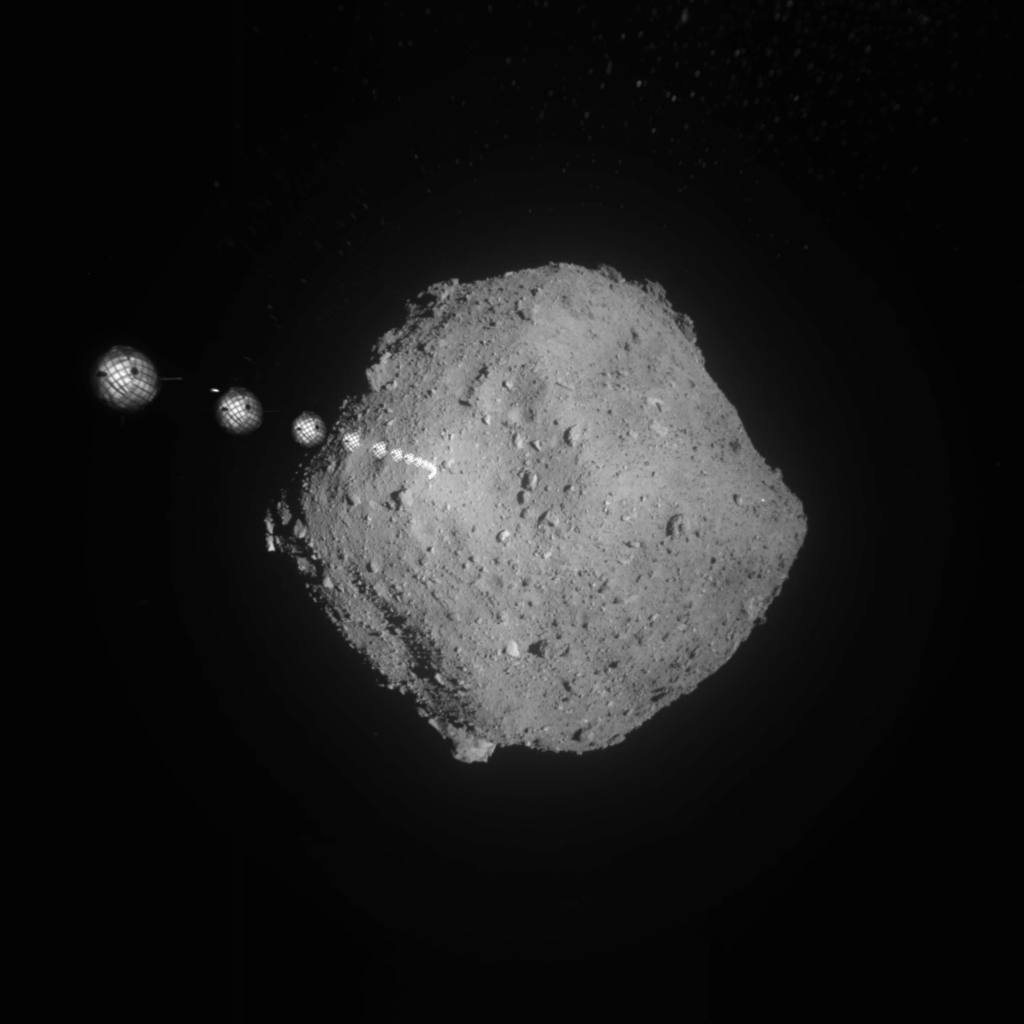Look Out Below! Japan's Hayabusa2 Drops Target Markers on Asteroid Ryugu

Japan's asteroid-exploring spacecraft has practiced its last task before heading home — and it made a nifty image as well.
The Hayabusa2 mission has been studying a space rock called Ryugu for more than a year. During that time, the spacecraft has snagged samples of the rock, created an artificial crater and released three small robots to explore Ryugu's surface. But Hayabusa2 has one more rover on board, dubbed MINERVA-II2.
And before the main spacecraft deploys that rover, the team overseeing the mission for the Japan Aerospace Exploration Agency (JAXA) wanted to put the vehicle through its paces one more time. That rehearsal, which took place Sept. 16 (Sept. 17 local time at mission control), sent two target markers toward the asteroid.
Related: Incredible Asteroid Landing Photos by Hayabusa2
Each target marker is a reflective ball that's about 4 inches (10 centimeters) across and filled with smaller balls — like a high-tech beanbag. Hayabusa2 launched with five of these markers and had already deployed two, one last October and one in May. Two more left the spacecraft during the rehearsal this week, according to JAXA.
During the procedure, the spacecraft photographed the target markers every 4 seconds, producing the raw material that mission personnel have turned into stunning would-be multiple-exposure images.
As the camera snapped, the target marker itself stayed more or less in the same place, while the spacecraft itself rose at a speed of about 4 inches per second, according to a statement from JAXA. All told, the target markers took a few days to reach the asteroid's surface, on account of the space rock's very weak gravity.
Breaking space news, the latest updates on rocket launches, skywatching events and more!
September 16 at 15:52 JST: the altitude of the spacecraft is 3.5km. The first image was captured by the telephoto ONC-T at 15:13 JST. The Urashima Crater fills the whole photo, whose width is about 390m. The second image was taken by the wide-angle ONC-W1 camera at 15:43 JST. pic.twitter.com/pf0ZYf4EKhSeptember 16, 2019
The rehearsal was originally scheduled for Sept. 5, but JAXA postponed the maneuver after Hayabusa2 briefly went into safe mode at the end of August. The safe mode was triggered by an anomaly during the testing of a long-unused reaction wheel. Though the issue was easy for spacecraft engineers to work around, it sent Hayabusa2 soaring to its "home position" 12.4 miles (20 kilometers) above the asteroid's surface.
Since deploying the two target markers, Hayabusa2 has focused on observing the pair, which it will continue to do until Sept. 23, according to JAXA. The agency has not yet announced when it will deploy the spacecraft's final rover.
That deployment marks the last task Hayabusa2 needs to complete before it ferries its precious space-rock cargo back to Earth. The spacecraft will leave Ryugu in November or December.
- Watch Japan's Hayabusa2 Grab a Piece of an Asteroid in This Incredible Video!
- Shadow Selfie! Japanese Asteroid Probe Snaps Amazing Post-Landing Pic
- Japan's Hopping Rovers Capture Amazing Views of Asteroid Ryugu (Video)
Email Meghan Bartels at mbartels@space.com or follow her @meghanbartels. Follow us on Twitter @Spacedotcom and on Facebook.

Meghan is a senior writer at Space.com and has more than five years' experience as a science journalist based in New York City. She joined Space.com in July 2018, with previous writing published in outlets including Newsweek and Audubon. Meghan earned an MA in science journalism from New York University and a BA in classics from Georgetown University, and in her free time she enjoys reading and visiting museums. Follow her on Twitter at @meghanbartels.
